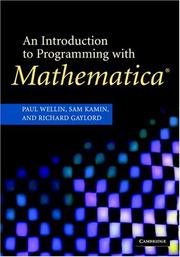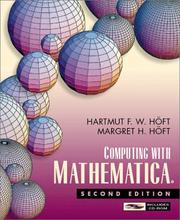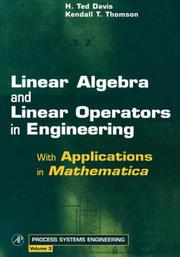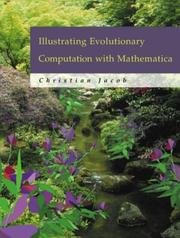| Listing 1 - 10 of 17 | << page >> |
Sort by
|

ISBN: 9780511801303 9780521846783 051108062X 9780511080623 0511801300 0511079869 9780511079863 9780511206658 0511206658 0521846781 1107141044 1280416084 9786610416080 0511170688 0511297831 9780511079108 0511079109 Year: 2005 Publisher: Cambridge [England] New York Cambridge University Press
Abstract | Keywords | Export | Availability | Bookmark
 Loading...
Loading...Choose an application
- Reference Manager
- EndNote
- RefWorks (Direct export to RefWorks)
Starting from first principles, this book covers all of the foundational material needed to develop a clear understanding of the Mathematica language, with a practical emphasis on solving problems. Concrete examples throughout the text demonstrate how Mathematica can be used to solve problems in science, engineering, economics/finance, computational linguistics, geoscience, bioinformatics, and a range of other fields. The book will appeal to students, researchers and programmers wishing to further their understanding of Mathematica. Designed to suit users of any ability, it assumes no formal knowledge of programming so it is ideal for self-study. Over 290 exercises are provided to challenge the reader's understanding of the material covered and these provide ample opportunity to practice using the language. Mathematica notebooks containing examples, programs and solutions to exercises are available from www.cambridge.org/wellin.
Book
ISBN: 1281054194 9786611054199 0080534953 1435604997 Year: 2002 Publisher: San Diego, Calif. : Academic Press,
Abstract | Keywords | Export | Availability | Bookmark
 Loading...
Loading...Choose an application
- Reference Manager
- EndNote
- RefWorks (Direct export to RefWorks)
This book provides an introduction to chemical engineering analysis- which reviews the processes and designs used to manufacture, use, and dispose of chemical products-and to Mathematica, one of the most powerful mathematical software tools available for symbolic, numerical, and graphical computing. Analysis and computation are explained simultaneously. The book covers the core concepts of chemical engineering, ranging from the conservation of mass to chemical kinetics. At the same time the text shows how to use the latest version of Mathematica, from the basics of writing a few lines of code
Chemical engineering. --- Chemical engineering. Mathematica (Computer program language). --- Chemistry, Analytic. --- Mathematica (Computer program language). --- Chemical & Materials Engineering --- Engineering & Applied Sciences --- Chemical Engineering --- Mathematica (Computer program language) --- Chemistry, Industrial --- Engineering, Chemical --- Industrial chemistry --- Domain-specific programming languages --- Engineering --- Chemistry, Technical --- Metallurgy

ISBN: 128105335X 9786611053352 0080488552 9780080488554 0123516668 Year: 2003 Publisher: Amsterdam Boston Academic Press
Abstract | Keywords | Export | Availability | Bookmark
 Loading...
Loading...Choose an application
- Reference Manager
- EndNote
- RefWorks (Direct export to RefWorks)
Computing with Mathematica, 2nd edition is engaging and interactive. It is designed to teach readers how to use Mathematica efficiently for solving problems arising in fields such as mathematics, computer science, physics, and engineering. The text moves from simple to complex, often following a specific example on a number of different levels. This gradual increase incomplexity allows readers to steadily build their competence without being overwhelmed. The 2nd edition of this acclaimed book features:* An enclosed CD for Mac and Windows that contains the entire text as

ISBN: 1281865923 9786611865924 184816131X 9781848161313 9781860943638 1860943632 9781281865922 6611865926 Year: 2003 Publisher: London Imperial College Press
Abstract | Keywords | Export | Availability | Bookmark
 Loading...
Loading...Choose an application
- Reference Manager
- EndNote
- RefWorks (Direct export to RefWorks)
This volume consists of papers delivered at the International Mathematica Symposium 2003 - an interdisciplinary meeting bringing together users of Mathematica in research and education. It gathers research papers, reports on classroom practice, reports on the use of Mathematica in industry and commerce, and descriptions of fresh applications.
Mathematica (Computer program language) --- Mathematics --- Math --- Science --- Domain-specific programming languages
Book
ISBN: 1783283009 9781783283002 1322166072 9781322166070 1783282991 9781783282999 9781783282999 Year: 2014 Publisher: Birmingham, [England] : Packt Publishing,
Abstract | Keywords | Export | Availability | Bookmark
 Loading...
Loading...Choose an application
- Reference Manager
- EndNote
- RefWorks (Direct export to RefWorks)
If you are planning to create data analysis and visualization tools in the context of science, engineering, economics, or social science, then this book is for you. With this book, you will become a visualization expert, in a short time, using Mathematica.

ISBN: 9780080510248 0080510248 012206349X 9780122063497 1281053805 9786611053802 Year: 2000 Publisher: San Diego : Academic Press,
Abstract | Keywords | Export | Availability | Bookmark
 Loading...
Loading...Choose an application
- Reference Manager
- EndNote
- RefWorks (Direct export to RefWorks)
Designed for advanced engineering, physical science, and applied mathematics students, this innovative textbook is an introduction to both the theory and practical application of linear algebra and functional analysis. The book is self-contained, beginning with elementary principles, basic concepts, and definitions. The important theorems of the subject are covered and effective application tools are developed, working up to a thorough treatment of eigenanalysis and the spectral resolution theorem. Building on a fundamental understanding of finite vector spaces, infinite dimensional Hilbert sp

ISBN: 0585457077 9780585457079 9781558606371 1558606378 9780080508450 0080508456 1281754951 9786611754952 Year: 2001 Publisher: San Francisco : Morgan Kaufmann Pub.,
Abstract | Keywords | Export | Availability | Bookmark
 Loading...
Loading...Choose an application
- Reference Manager
- EndNote
- RefWorks (Direct export to RefWorks)
An essential capacity of intelligence is the ability to learn. An artificially intelligent system that could learn would not have to be programmed for every eventuality; it could adapt to its changing environment and conditions just as biological systems do. Illustrating Evolutionary Computation with Mathematica introduces evolutionary computation to the technically savvy reader who wishes to explore this fascinating and increasingly important field. Unique among books on evolutionary computation, the book also explores the application of evolution to developmental processes in n

ISBN: 1558606378 9786611754952 0080508456 1281754951 0585457077 9780585457079 9781558606371 9780080508450 Year: 2001 Publisher: San Francisco : Morgan Kaufmann Pub.,
Abstract | Keywords | Export | Availability | Bookmark
 Loading...
Loading...Choose an application
- Reference Manager
- EndNote
- RefWorks (Direct export to RefWorks)
An essential capacity of intelligence is the ability to learn. An artificially intelligent system that could learn would not have to be programmed for every eventuality; it could adapt to its changing environment and conditions just as biological systems do. Illustrating Evolutionary Computation with Mathematica introduces evolutionary computation to the technically savvy reader who wishes to explore this fascinating and increasingly important field. Unique among books on evolutionary computation, the book also explores the application of evolution to developmental processes in n
Book
ISBN: 9780323984362 0323984363 9780128241608 0128241608 Year: 2023 Publisher: London : Academic Press,
Abstract | Keywords | Export | Availability | Bookmark
 Loading...
Loading...Choose an application
- Reference Manager
- EndNote
- RefWorks (Direct export to RefWorks)
"Differential Equations with Mathematica, Fifth Edition uses the fundamental concepts of the popular platform to solve (analytically, numerically, and/or graphically) differential equations of interest to students, instructors, and scientists. Mathematica’s diversity makes it particularly well suited to performing calculations encountered when solving many ordinary and partial differential equations. In some cases, Mathematica’s built-in functions can immediately solve a differential equation by providing an explicit, implicit, or numerical solution. In other cases, Mathematica can be used to perform the calculations encountered when solving a differential equation."--
Differential equations --- Data processing. --- 517.91 Differential equations --- Mathematica (Computer program language) --- Domain-specific programming languages --- Programming Languages --- Mathematical Concepts --- Mathematics --- Programming Languages. --- Mathematical Concepts. --- Mathematics.
Book
ISBN: 9798868803482 Year: 2024 Publisher: Berkeley, CA : Apress : Imprint: Apress,
Abstract | Keywords | Export | Availability | Bookmark
 Loading...
Loading...Choose an application
- Reference Manager
- EndNote
- RefWorks (Direct export to RefWorks)
Enhance your data science programming and analysis with the Wolfram programming language and Mathematica, an applied mathematical tools suite. This second edition introduces the latest LLM Wolfram capabilities, delves into the exploration of data types in Mathematica, covers key programming concepts, and includes code performance and debugging techniques for code optimization. You’ll gain a deeper understanding of data science from a theoretical and practical perspective using Mathematica and the Wolfram Language. Learning this language makes your data science code better because it is very intuitive and comes with pre-existing functions that can provide a welcoming experience for those who use other programming languages. Existing topics have been reorganized for better context and to accommodate the introduction of Notebook styles. The book also incorporates new functionalities in code versions 13 and 14 for imported and exported data. You’ll see how to use Mathematica, where data management and mathematical computations are needed. Along the way, you’ll appreciate how Mathematica provides an entirely integrated platform: its symbolic and numerical calculation result in a mized syntax, allowing it to carry out various processes without superfluous lines of code. You’ll learn to use its notebooks as a standard format, which also serves to create detailed reports of the processes carried out. .
Mathematica (Computer program language) --- Wolfram language (Computer program language) --- Mathematics --- Artificial intelligence. --- Data processing. --- Programming languages (Electronic computers). --- Artificial intelligence --- Machine learning. --- Programming Language. --- Data Science. --- Machine Learning.
| Listing 1 - 10 of 17 | << page >> |
Sort by
|

 Search
Search Feedback
Feedback About UniCat
About UniCat  Help
Help News
News